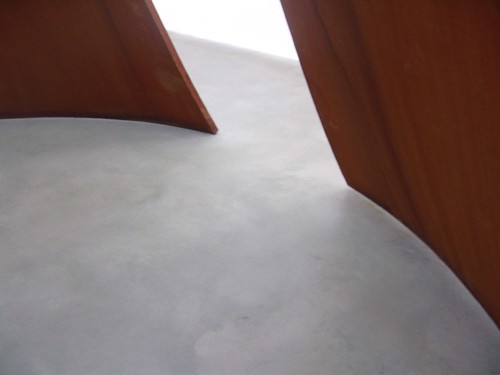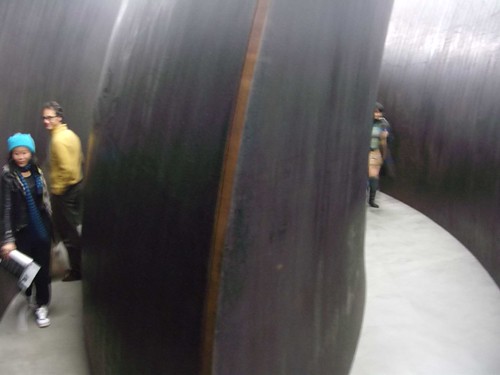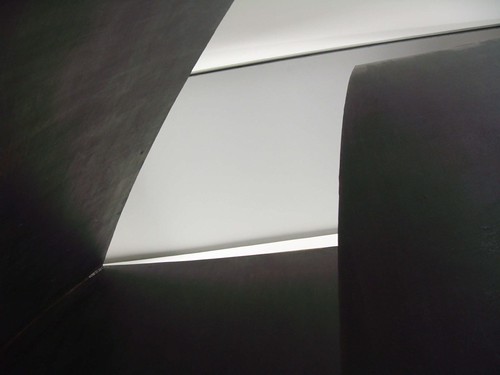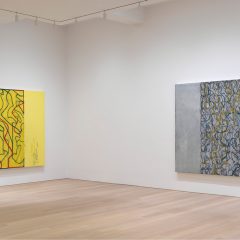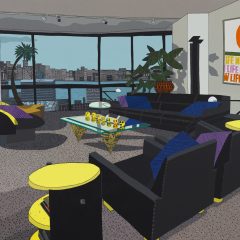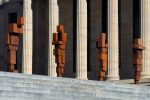Post by Max Mulhern
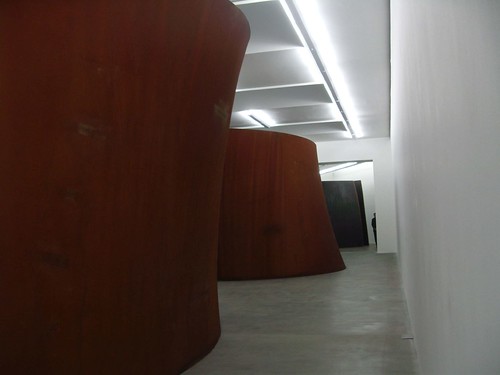
Richard Serra at Gagosian in London, installation detail
The verb is one of the most powerful tools in a sculptor’s toolbox. Richard Serra once made a list of the verbs describing his actions when sculpting.
“To Lift” was one such verb. Once he lifted the edge of a rectangular rubber mat and in one action created volume and contour (and a sculpture).
To Roll, To Bend, To Curve and To Cut are other verbs that pop to mind as well although, surprisingly, To Construct doesn’t. To Pose (Juxtapose) and To Balance take its place.
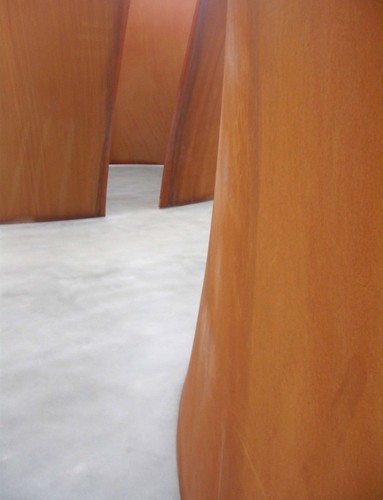
At first glance Serra’s current show at Gagosian in London appears to be an ode to the supertanker. We first see one of two similar works entitled “TTI London” which are torqued toruses composed of two complex curved pieces of 2” thick steel that are forming an oval on the floor. The two works are similar but are in fact inversions of each other with one opening at its top the other closing there. We gain entrance to the center of these works via a slit created where the two sheets fail to meet.
Lost in space
Once in the center we don’t feel so much that we are in the piece but rather that we are on the other side of it.
Serra’s father was a shipbuilder and the pride that the father swelled up with when he saw his ships launched greatly impressed Serra as a child. Rivets, nuts and bolts and welds became a seamless whole gliding on the sea.
The magnetic pull
This seamlessness is present here and has a powerful pull on us. The walls are membranes between spaces that exert a kind of magnetic pull on us. Indeed they would throw a compass reading out of whack with deviation. As we walk around these structures we feel like we are in a pleasure craft cruising among the ships in New York City harbor. Massive floating walls either flaring out over our heads opening the hull to the sky as if to show God that there is no Jonah onboard or flaring inwards leading the way to beneath the keel. The only thing missing are names and ports of call.
These huge sensual chalice curve pieces flow like waterfalls and the up and down drafts of the weather. Their verbal-ness renders them unseizable and unstoppable. They are the essence of utilitarian objects stripped of their utilitarian attributes (i.e. deck, keels, masts and props). Though they are the size of buildings they retain the agility of marquees.
We approach the masterwork “Open Ended” from the side and are met with a concave face that rolls up and away from us like the backside of a wave or the flank of a whale. Six massive sheets of steel wall lean and counterbalance against each other creating three toruses meeting three spheres. These, in turn, are positioned to create six corridors leading to a central core. We can enter this structure from two different ends that propose two different spatial experiences. Depending on the entry you will be walking between either two toruses or two spheres until you reach the core whose two walls consist of one torus and one sphere. You then continue and exit through a corridor with a totally different geometrical configuration (if you arrived by torus you will leave by sphere).
For this writer/sailor the variable geometry was like the heeling/capsizing one can experience at sea in a boat designed to be upright. It is supposed to be disorienting (think rational pure form geometry based optical illusion verses the emotionally disturbed geometry of Dr. Caligari’s Cabinet). Personally, I felt at home and I was reminded of the walk to the top of Brunelleschi’s Duomo in Florence. You have to follow a narrow stairway snaking between the inner and outer skin of the dome. The outer skin folds over you and the inner skin falls away from you. Try it sometime. THAT’S scary. “Open Ended” proposes a labyrinthine odyssey but there are neither Minotaur nor dead ends contained within. Rather there are intersections that denote the pointy and curved extremities of ships. I found the shapes comforting. We are traveling safe within the hold of the work.
Above us the edges of the walls draw geometric fragments that recall Ellsworth Kelly.
Serra pushes the technological envelope in these works and a video of their birth would be welcome. As an acolyte of “process” I am surprised not to see more technical information. These forms do evoke the Mobius Strip but the integrity of the side is maintained. This is not trickery but rather the form in majestic movement. Many different verbs were required to make this work but no one single verb can describe the resulting.
(For a video on the exhibit, including Serra himself talking about his work, go here).
–Artist Max Mulhern last wrote for artblog about Mark Rothko at the Tate Modern


